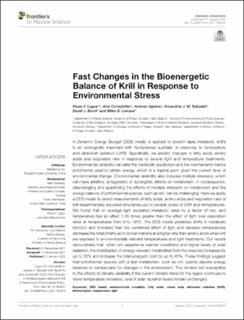| dc.description.abstract | A Dynamic Energy Budget (DEB) model is applied to predict rapid metabolic shifts in an ecologically important krill, Nyctiphanes australis, in response to temperature and ultraviolet radiation (UVR). Specifically, we predict changes in fatty acids, amino acids and respiration rate in response to several light and temperature treatments. Environmental variability can alter the metabolic equilibrium and the mechanisms marine ectotherms used to obtain energy, which is a topical point given the current level of environmental change. Environmental variability also includes multiple stressors, which can have additive, antagonistic or synergistic effects on metabolism. In consequence, disentangling and quantifying the effects of multiple stressors on metabolism and the energy balance of ecthothermal species, such as krill, can be challenging. Here we apply a DEB model to direct measurements of fatty acids, amino acids and respiration rate of krill experimentally exposed simultaneously to several doses of UVR and temperatures. We found that on average light escalates metabolic rates by a factor of two, and temperature has an effect 1.35 times greater than the effect of light over respiration rates at temperatures from 9 to 19°C. The DEB model predicted shifts in metabolic function and indicated that the combined effect of light and elevated temperatures decrease the total of fatty acid concentrations at a higher rate than amino acids when krill are exposed to environmentally relevant temperatures and light treatments. Our results demonstrate that, when krill experience warmer conditions and higher levels of solar radiation, the mobilization of energy-relevant metabolites from the reserves increases by up to 36% and increase the total energetic cost by up to 45%. These findings suggest that ectothermal species with a fast metabolism, such as krill, quickly deplete energy reserves to compensate for changes in the environment. This renders krill susceptible to the effects of climate variability if the current climatic trend for the region continues to show temperature increases, even if solar radiation levels remain unchanged. | en_US |
